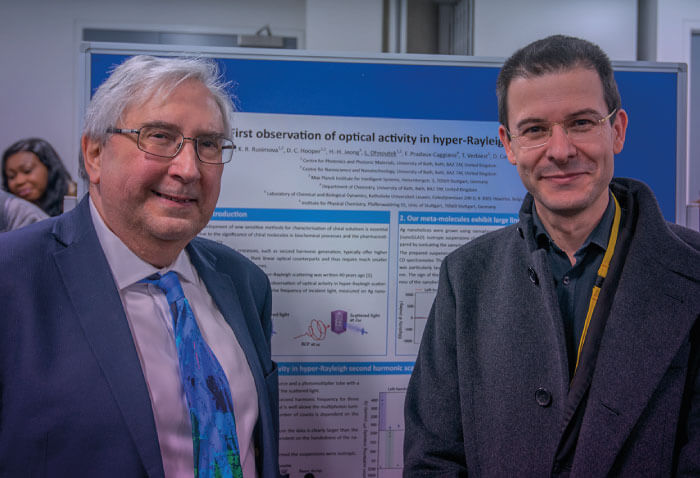How can a guitar be distinguished from a violin? The physical characteristics of the two instruments are, of course, very different. But what truly separates the two is the difference that can be heard between them. If the same note is played on these instruments they will sound different because each instrument, in addition to the note played, plays a series of tiny notes called “harmonics”.

Forty years ago, David Andrews, Professor of Chemistry at the University of East Anglia, theorized that chiral molecules (molecules which are non-superimposable on their mirror images) produced their own harmonics as they scatter light. But instead of relating to sound, these harmonics related to color. Andrews believed that the color changes observed in the scattered light would help distinguish which way a molecule twisted.
While the theory had a logical basis, it remained unproven. Scientists had attempted to prove the theory using natural molecules but the sought after optical properties of chiral structures couldn’t be observed. Now, however, Ventsislav Valev, professor in the department of physics at the University of Bath, UK, and his colleagues have demonstrated that the physical effect does exist.
Using meta-molecules (tiny metal springs made of silver), the team was able to observe optical activity in hyper-Rayleigh scattering – for the first time (1). Though the same physical effect is possible using natural molecules, it is too small to detect or measure using currently available methods.
“The method we used is 100,000 times more sensitive than conventional approaches to the measurement of chirality. Despite its simplicity, this method is very robust and removes the possibility of producing false positive results,” explains Valev. The team fired a laser at the nanoscopic silver springs dispersed in water within a glass container; the circular polarization of the laser was changed and the resulting light scattering effect enabled the chirality of the molecules to be measured.
Valev believes that the volume of waste produced by the pharma industry in its attempts to determine the chirality of drugs could be dramatically cut using the technique developed by his team.
The sensitivity of the test also means that smaller quantities of product can be used in quality control tests. He adds that the process is well suited to lab-on-a-chip manufacturing that relies on microfluidics, the study of the behavior of chemicals through microscopic capillaries. These mini manufacturing plants facilitate chiral exploration and could be used to produce pharmaceuticals for personal consumption as and when they are required. Though current lab-on-a-chip devices cannot achieve this in a practical way, Valev envisions that it could be achieved using microfluidic methods.
Despite many having previously dismissed Andrews’ theory, Valev was always convinced that the effect was real. He began to piece together the puzzle when he came across the work of Peer Fischer, Professor of Physical Chemistry at the University of Stuttgart, Germany.
The academic had fabricated the silver metamolecules, which Valev combined with his highly sensitive experimental setup to visualize the color-changing physical effect. Valev now intends to apply a similar setup to natural molecules to demonstrate that the chirality of these structures can be measured.
“Science is the greatest intellectual adventure of humankind,” says Valev. “It is an adventure that spans millennia. Within this context, 40 years is not a long time. I feel greatly privileged to be part of this adventure with our team’s contribution.”
References
- VK Valev et al., “First observation of optical activity in hyper-Rayleigh scattering”, Phys Rev X 9, 011024 (2019). DOI: 10.1103/ PhysRevX.9.011024




